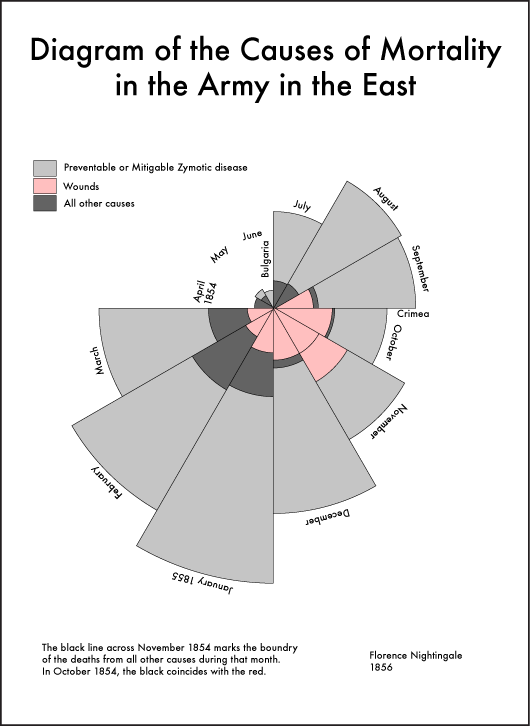Florence Nightingale was born in 1820. That same year the famous HMS Beagle was launched. Later, it would later take Charles Darwin half-way around the world and reserve its place in history. Maine was accepted into the US as its 23rd state and King George IV ascended to the thrown of the United Kingdom.
Florence Nightingale was born into a well-off, upper-class family, so in 1845 when she announced that she was to pursue nursing, it didn’t go down well. Against the will and anger of her family, she worked hard to educate herself. A women of her status and situation was expected to become a wife and mother, not a nurse.
For the next several years she travelled around, researching, writing and learning. She had a few courtiers in the mean time, but rejected them convinced that marriage would interfere with her mission to become a nurse and help others.
In late 1853, she became the superintendent at the Institute for the Care of Sick Gentlewomen in London. She remained there for a little over a year before being sent to Turkey to help with the Crimean War effort. The conditions that she arrived to were appalling! Along with that, she had to deal with stubborn officials and overworked staff.
At this time in history, hygiene was never considered and therefore infections ran rampant through the wounded soldiers. Many of the soldiers committed to hospital from the battlefield died of non-fatal wounds. These were the days before anyone realized that viruses and diseases were transferred by blood and liquids rather than air. Many doctors didn’t wash their operating clothes, because the more grubby they looked, the busier and more important he must have been.
Florence Nightingale pushed hard for sanitary improvements. She requested the drains to be cleaned so that the “fowl air” could be removed. This was still a time when the miasmatic theory ran strong in medicine and she was pushing to improve the conditions based on what she thought was best at the time.
Years later, when she was back in England compiling reports for the Royal Commission on the Health of the Army, that she looked at her statistics and realized that the poor living conditions were the major reason for death while in hospital.
While compiling statistics about the hospital deaths and medical treatment during the war for the members of parliament and civil services, she realized that no one was going to read it. They either couldn’t be bothered or did not have the mathematical background to understand the tables of information. 150+ years later and not much has changed! Instead, she introduced the coxcomb, a polar area chart, which better visualized the information in an easily, more digestible, executive report style infographic. It is modelled after the pie chart, but each wedge extends outward to represent the volume. Sort of a circular bar chart.
The charts succeeded in their goal, because it pushed the Royal Commission in India to enact many of her hygienic suggestions. After which, the number of hospital deaths was drastically reduced. It was due to the meticulous statistics and data representations that helped to sway opinions on the matter of hygiene and save countless lives.
In 1859, Florence Nightingale was the first women to be elected to the Royal Statistical Society and then later to the American Statistical Association. Many of her ideas were taken-up by the Americans, specifically the Union, during the American Civil War. Having hygienic hospital conditions saved the lives of many young men and helped to keep a country held together.
May 12th each year is International Nurses’ day. It’s no coincidence that it is also Florence Nightingale’s birthday. The date was chosen for her contributions to the field.
The lady with the lamp, as she was known had an unusual upbringing, her father believed that women should be education, and therefore she learned several languages, philosophy, history, writing and mathematics. It was this education that allowed her to be so meticulous in her desire to improve the health and well-being of others that she noted down all the statistics that she did. It also allowed her to reconstruct the values in a way to spot trends that no one else had noticed.
Florence Nightingale has made an indelible mark in history and her contributions are still felt to this day across multiple disciplines.
